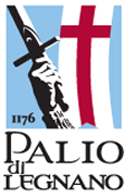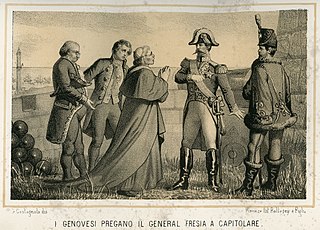Related Research Articles

The Italian Riviera or Ligurian Riviera is the narrow coastal strip in Italy which lies between the Ligurian Sea and the mountain chain formed by the Maritime Alps and the Apennines. Longitudinally it extends from the border with France and the French Riviera near Ventimiglia eastwards to Capo Corvo which marks the eastern end of the Gulf of La Spezia and is close to the regional border between Liguria and Tuscany. The Italian Riviera thus includes nearly all of the coastline of Liguria. Historically the "Riviera" extended further to the west, through what is now French territory as far as Marseille.

Palio is the name given in Italy to an annual athletic contest, very often of a historical character, pitting the neighbourhoods of a town or the hamlets of a comune against each other. Typically, they are fought in costume and commemorate some event or tradition of the Middle Ages and thus often involve horse racing, archery, jousting, crossbow shooting, and similar medieval sports. Once purely a matter of local rivalries, many have now become events that are staged with an eye to visitors and foreign tourists.

Legnano is an Italian town and comune in the north-westernmost part of the Province of Milan, about 20 kilometres (12 mi) from central Milan. With 60,259, it is the thirteenth-most populous township in Lombardy. Legnano is located in the Alto Milanese and is crossed by the Olona river.

Nervi is a former fishing village 12 miles (19 km) northwest of Portofino on the Riviera di Levante, now a seaside resort in Liguria, in northwest Italy. Once an independent comune, it is now a quartiere of Genoa. Nervi is 4 miles (7 km) east of central Genoa.

Boccadasse is an old mariners' village of the Italian city of Genoa. It lies within the borders of the neighbourhood of Albaro. In today's administrative subdivision it is located in the Municipio VIII - Medio Levante area which includes the neighbourhoods of Albaro, Foce, San Martino. Boccadasse is bordered on the west side by Via Felice Cavallotti, by Via Caprera on the northern side and by Via Capo di Santa Chiara on the eastern side. Naturally, it is delimited by the sea to the south.

The Genoa–Pisa railway is one of the trunk lines of the Italian railway network. It runs along the Ligurian coast from Genoa to Pisa through the Riviera di Levante and the Versilia. It passes through the cities of Massa, Carrara and La Spezia. South of Pisa the Pisa–Rome line continues along the Tyrrhenian coast to Rome. The line is double track and is fully electrified at 3,000 V DC. Passenger traffic is managed by Trenitalia.

Antonio Brilla was a prolific Italian sculptor and ceramic artist mainly active in Liguria. He travelled in 1838 to Florence to study masterworks, where he met Giovanni Duprè and Lorenzo Bartolini. He returned to Savona to establish a studio. Two of Antonio's sons also were artists.
The following is a timeline of the history of the city of Genoa, Liguria, Italy.

Traditions of Italy are sets of traditions, beliefs, values, and customs that belongs within the culture of Italian people. These traditions have influenced life in Italy for centuries, and are still practiced in modern times. Italian traditions are directly connected to Italy's ancestors, which says even more about Italian history.

Sturla (Italian: [ˈsturla], Ligurian: [ˈstyɾla]) is a quartiere of Genoa, Italy. It began life as an ancient fishing village which developed around a number of small coves – Sturla a Mare, at the mouth of the Sturla river, Vernazzola and Boccadasse. Sturla is located in the Golfo di Sturla.

The Palio di Legnano is a traditional event generally held on the last Sunday of May in the City of Legnano, Italy, to recall the Battle of Legnano held on 29 May 1176 by the Lombard League and the Holy Roman Empire of Frederick Barbarossa. This Palio is composed by a medieval pageant and a horse race. Until 2005 the whole event was named Sagra del Carroccio.

The AMT Genova, formally known as the Azienda Mobilità e Trasporti and formerly as the Azienda Municipalizzata Trasporti, is a joint stock company that holds the concession for public transport in the Italian city of Genoa.

The term Great Genoa refers to the present area of the municipality of Genoa, in the north west of Italy. Great Genoa extends for over 30 km along the coast of Ligurian Sea from Nervi to Voltri, and up the Polcevera valley of the Polcevera river and the Bisagno river valley of the Bisagno river.

The Regatta of the Historical Maritime Republics is a sporting event of historical re-enactment, established in 1955 with the aim of recalling the rivalry of the most famous Italian maritime republics: those of Republic of Amalfi, Republic of Pisa, Republic of Genoa and Republic of Venice, during which four rowing crews representing each of the republics compete against each other. This event, held under the patronage of the President of the Italian Republic, takes place every year on a day between the end of May and the beginning of July, and is hosted in rotation between these cities. The regatta is preceded by a historical procession, during which parade through the streets of the city organizing some figures that play the role of ancient characters that characterized each republic.

The contrade of Legnano are the eight historical subdivisions into which the city of Legnano, in Lombardy, in Italy, is divided. They participate annually in the Palio di Legnano.

The siege of Genoa on 13–18 April 1814 was the capture of the port city of Genoa by a British–Sicilian army from the First French Empire. It was the last battle of the War of the Sixth Coalition's Italian campaign, as on 4 April, Napoleon had abdicated as emperor of France.
The Diotto is the celebration for the anniversary of the founding of Scarperia, held each year on September the 8th. The name itself recalls the date: dì as for "day" and otto which means "eight". Actually, the founding began September the 7th 1306, but it was decided that the anniversary date should have been the day after, birth of the Virgin Mary.
The Palio del Golfo is a rowing challenge that is held every year, on the first Sunday of August, in the sea of the Gulf of La Spezia.
References
- ↑ "Genova, alla Foce ritorna il Palio Marinaro di San Pietro: sfida in mare tra gli storici rioni della città". ilsecoloxix.it. ilsecoloxix.it. 1 July 2022. Retrieved 2 July 2022.
- ↑ "The Palio di San Pietro". visitgenoa.it. Comune di Genova. Retrieved 2 July 2022.
- ↑ "Il Palio di San Pietro". lamialiguria.it. Regione Liguria. Retrieved 2 July 2022.
- ↑ "Il Palio Marinaro di San Pietro torna alla Foce". asdfoce.it. asdfoce.it. Retrieved 2 July 2022.
- ↑ "57° edizione Palio Marinaro di San Pietro". acompagna.org. acompagna.org. Retrieved 3 July 2022.
- ↑ "58° edizione Palio Marinaro di San Pietro". acompagna.org. acompagna.org. Retrieved 4 July 2022.
- ↑ "59° Palio Marinaro di San Pietro". acompagna.org. acompagna.org. Retrieved 3 July 2022.
- ↑ "60° Palio Marinaro di San Pietro". acompagna.org. acompagna.org. Retrieved 3 July 2022.
- ↑ "61° Palio Marinaro di San Pietro". acompagna.org. acompagna.org. Retrieved 3 July 2022.
